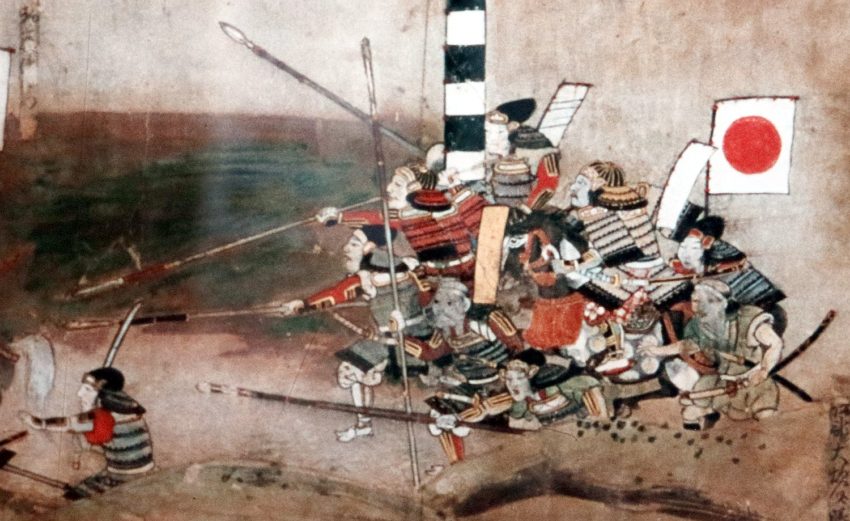It may be that the inspiration for the Japanese horse killing sword came from a muscular soldier bemoaning his failure in battle. His weakness arose from his inability to bridge the gap between himself and a samurai on horseback; the soldier had neither the money nor skill to acquire a horse of his own. So, if you can’t deal with your opponent because of his advantage, why not focus on turning his advantage into a disadvantage?
Thus, the zanbato or “Japanese horse killing sword” came into being.
This article intends to discuss and highlight the various historical and realistic details of this tribute to overcompensated military might. You’ll also read about some of the examples of its prevalence in history and pop culture.
History: What is known of the Japanese horse killing sword
You may already be aware that the Japanese horse killing sword is known as a zanbato, but did you realize that this weapon may have been inspired by the Chinese zhanmadao? Both weapons were impressively-sized single-edged blades that were designed to cleave through a horse and its rider with one massive swing.
The zanbato first appears during the Heian Era of Japan (794-1185). While the zhanmadao first appeared during China’s Han Dynasty (206 BC – 220 AD), it became a popular anti-cavalry weapon during the Song Dynasty (960-1279). Given the geographical closeness and political closeness between the two lands, it does not seem unreasonable to assume that many of the first zanbato to reach Japan came from China. The horse-killing blades would have carried by either merchants or mercenaries
The only notable difference between certified a Japanese zanbato and a Chinese zhanmadao is the length of the blade’s curve. While both weapons featured a handle long enough to support two-handed grips, the curve of a zanbato begins at a point that brings a katana to mind. And if you’re into statistics, a zanbato’s total length would be at least 78 inches – at least 59 of which would be entirely dedicated to the blade.
The term zanbato and its kanji characters, 斬馬刀
Yet again we must refer to the similarities between the zanbato and the zhanmadao. Both weapons are written with the same characters, 斬馬刀. This can be translated as “horse-chopping saber” or “horse-slaying sword” in English. Sure, these are not the exact same phrases, but the general fearsome meaning remains the same.
This is a blade that is powerful enough to take two lives in one swing.
How exactly the zanbato was used in warfare
As you would imagine with a weapon called “a Japanese horse killing sword,” the zanbato was used by anti-cavalry units. Foot soldiers would take these massive blades and use them to slice through a horse’s legs. With this powerful technique they would instantly remove two of the major advantages the horsemen enjoyed: reach and mobility.
If the blow did not end up killing the horse’s rider immediately, not to worry. The ensuing chaos – you try sitting atop a galloping beast that suddenly lost its legs! – would result in the samuraiSAMURAI 侍 "warrior serving a lord" learn more... being either crushed or left pinned under his panicked steed. Now he was at the mercy of the zanbato’s wielder; the soon-to-be-victor would likely use a tanto or other short blade to administer the killing blow.
This tactic was explicitly mentioned in a Song military manual written in 1072. The most detailed discussion of the weapon’s military use occurs in reports of battles with the armies of China’s Jin from 1129 to 1141.
The end of the zanbato’s time
As to why the effective Japanese horse killing sword fell out of favor, it’s likely that polearms grew in prominence and became cheaper to mass produce. A smith could produce multiple spearheads from the same amount of metal used to forge a single zanbato.
The tactical advantage was stark: A polearm allowed a warrior to defeat a samurai directly and preserve the valuable horse. As if polearms were not enough of a tool to replace the zanbato, Portugal’s inadvertent introduction of firearms to Japan did much to whittle away the effectiveness of samurai cavalry.
Examples of the zanbato today
While only a few zanbato survive to this day, one notable example appears similar to a nagamaki. It bears a 15-inch-long wrapped handle. The one oddity of this particular weapon is that its blade only has a slight curve along its second half. Most Japanese swords are of a fixed style, but the Japanese horse killing sword is clearly in its own unique class.
Japanese horse killing sword in popular culture
In addition to the few fascinating examples of this weapon in museums and history books, there are dozens of films, anime and manga that feature a horse-killing sword.
- No discussion of the zanbato in fiction would be complete without mentioning Bleach. In this anime and mange series, the main character Ichigo Kurosaki uses Zangetsu, a weapon whose initial form resembles a massive butcher’s cleaver.
- Berserk is a manga and anime title whose main character, known simply as Guts, wields a massive zanbato known as Dragonslayer.
- Dark Souls and Dark Souls Remastered, video games, allow its players to wield Murakumo, a type of Japanese horse killing sword that belongs to either the Greatsword or Ultra Greatsword group (depending on the particular version). The games describe it as a giant curved blade that was forged in the East, that cuts like a katana, but that is also quite heavy. Murakumo requires high levels of strength and dexterity to even acquire, and a decent amount of stamina to avoid becoming winded after one or two swings. The weapon’s name means “gathering clouds” and may have been taken from the actual sword that is part of the Japanese Imperial Regalia.
- The Japanese role-playing game Final Fantasy VII is notable for featuring two major characters that use zanbato as their signature weapons, even if the two styles are quite different from each other. Protagonist Cloud Strife wields a hulking blade known as the Buster Sword, while lead antagonist Sephiroth wields a narrow and exceptionally lengthy blade known as Masamune.
- Final Fantasy X also features a zanbato when the player pays to summon Yojimbo. This undead samurai is capable of using a technique called Zanmato: If the amount of money the player decides to pay is sufficient, he uses a zanbato to instantly defeat any regular enemy.
- Characters in the Fire Emblem game series can use a zanbato. This weapon gives the character the ability to inflict additional damage to mounted units.
- Lone Wolf and Cub‘s Ogami Itto learned a style of swordsmanship known as Suioryu Zanbato. (However he uses a dotanuki katana to perform attacks in that style.)
- Of Naruto‘s “Seven Swordsmen of the Mist,” fully four of them wield zanbatos. The individual names for their zanbatos are:
- Hiramekarei, whose blade remains wrapped in bandages
- The massive butcher’s knife-like Kubikiribocho, whose name literally translates as “decapitating carving knife”
- Samehada, whose name means “shark skin” due to its appearance
- Shibuki, whose name means “splash” and whose blade is lined with explosive scrolls.
- Episode 137 of the Naruto anime also mentions that at least one member of the Fuma clan uses a zanbato.
- In One Piece, both Arlong’s Kiribachi sword and Dracula Mihawk’s Yoru are prime examples of the Japanese horse killing sword. It is worth mentioning that even the name of Arlong’s weapon alludes to its saw-like nature; it translates as “cutting plectrum” (a plectrum is a triangular object often usen to pluck something like a string instrument).
- Sanosuke Sagara began the series and films of Rurouni Kenshin by using a zanbato as his signature weapon. He eventually transitions into a full-on unarmed combatant after Kenshin easily defeats him. Sanosuke realizes that the superior mobility and greater options of fighting unarmed outweight the massive power derived from a single zanbato swing.
- The player can give a zanbato to someone in the Scribblenauts series of games.
- The Monster Hunter game series is notable for having multiple classes of weapons available to handle massive beasts. Every single example of the Long Sword weapon class is inspired by zanbato. It is also worth mentioning that players will rarely encounter monsters smaller than a horse.
- Dungeon Fighter Online gives the Slayer, its swordsman class, the ability to specialize in zanbato weapons.
- Two versions of the Power Rangers shows feature lead characters who use a zanbato weapon, known as Rekka Daizantou (meaning “Blazing Great Slicing Sword”). The first occurs in Power Rangers Samurai, where it is wielded by the red ranger. The second occurs in Power Rangers Super Megaforce and is simply the same weapon used by samurai Ranger Red from the first series.
- Sakon Shima uses a zanbato in the dramatization of the Sengoku Jidai that is the Samurai Warriors game series.
- Gleameyes, the hulking ogre who serves as the boss of floor 74 in the tower dungeon of Sword Art Online, is described as using a zanbato to kill adventurers.
- Inuyasha features a character known as Bankotsu, a reanimated human who has been granted more than enough strength to wield Banryu, a zanbato larger than his own body and whose name translates as “barbaric dragon.”
Can you get your very own zanbato?
With a name like “horse killing sword,” it’s no wonder that zanbato-type weapons have such a grip on the imagination. In the world of Japanese swords, these legendary blades from the ancient past still inform notions of strength, cunning, efficiency, and might.
The only zanbato you are likely to own in your own collection is going to be a modern reproduction, even perhaps a piece inspired by anime or manga.
So if you don’t actually need a zanbato to kill your enemies’ horses, no problem. Just displaying and showing off a Japanese horse killing sword on your wall or in your cabinet is enough to make owning it worth it many times over, especially when you know the awesome history of these awesome blades.

